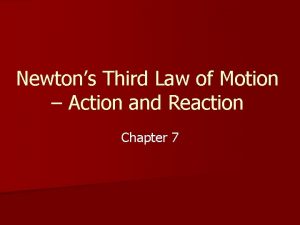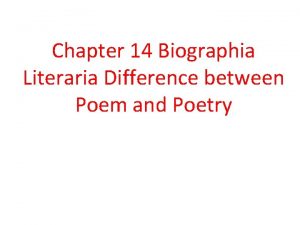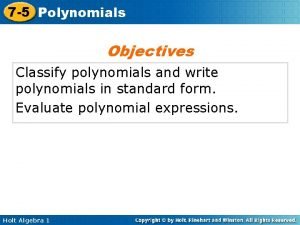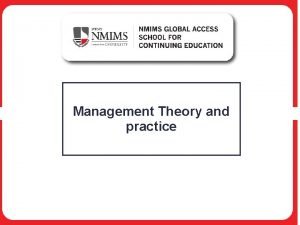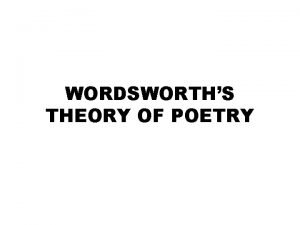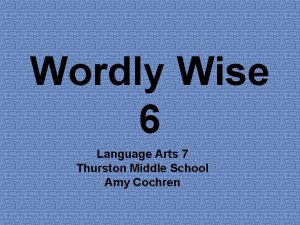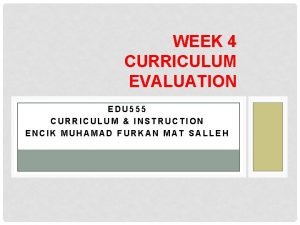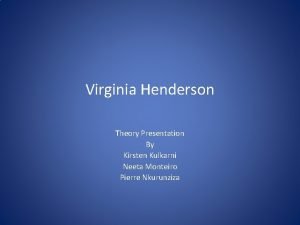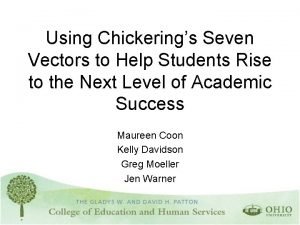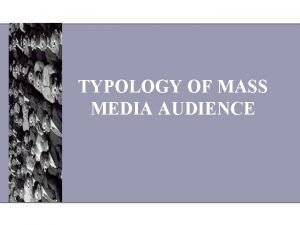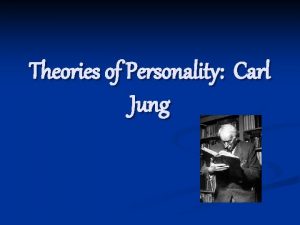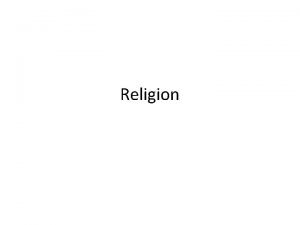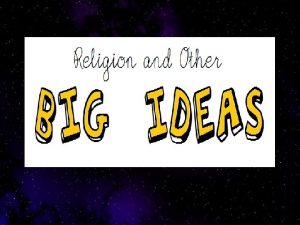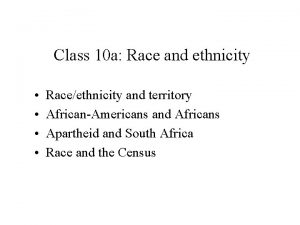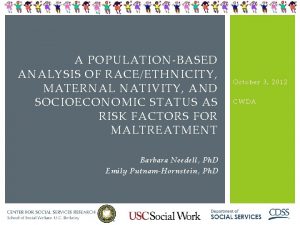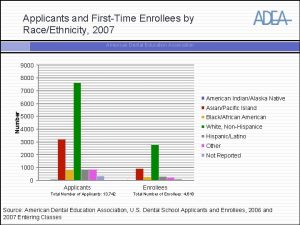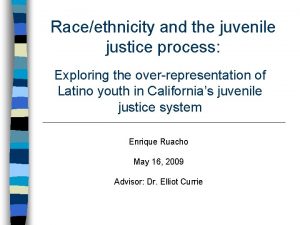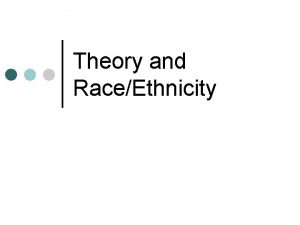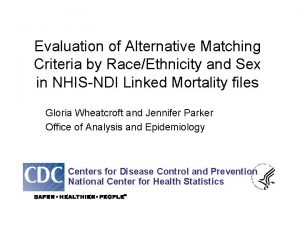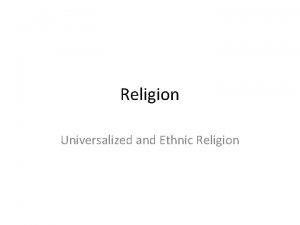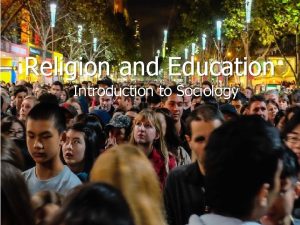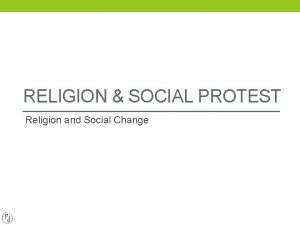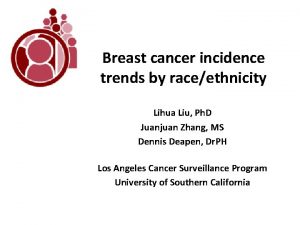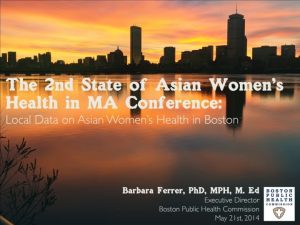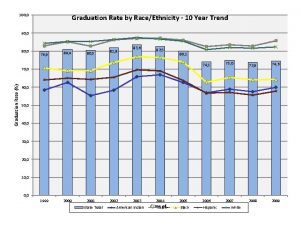RELIGION AND RACEETHNICITY RELIGION What is religion According





















- Slides: 21

RELIGION AND RACE/ETHNICITY

RELIGION • What is religion? • According to Emile Durkheim: “a unified system of beliefs and practices which unite into a single moral community called a Church, all those who adhere to them” • According to Milton Yinger, this is how religion functions: “a system of beliefs and practices by means of which a group of people struggles with the ultimate problems of human life” (like death, suffering, evil, etc. ) • This definition is broader, and can include things like science and technology • Which one makes more sense to you? Is there anything missing in these definitions? • Is the “supernatural” necessary for the definition? • Characteristics of religion • Social phenomenon involving grouping people around a faith (sense of belonging) • Include beliefs, rituals, morals, symbols, worldviews • Shared system of meaning and expectations

RELIGION • Some important differences: • Sacred: something that has a quality greater than humankind, is related to the supernatural • Secular: everything else not related to the supernatural • Spirituality: a personal connection with something greater than oneself (a higher power/force) • Spirituality may or may not include involvement in organized religion • So what’s the difference between religion and spirituality? Fill in the blank: religion is more ______, while spirituality is more _____ • The Sacred Canopy • Peter Berger’s idea of how humans place meaning on reality • This meaning can be otherworldly in nature—trying to understand the world as a whole as significant, having greater meaning • This greater meaning legitimate society; how? • This “canopy” protects us and was/is constructed by us • The sacred canopy is religion

RACE AND ETHNICITY • What is race? • Ways in which we categorize people based on physical characteristics (e. g. skin tone, eye/lip/nose shape, hair texture) • Race is not a biological reality. It is a social construction, meaning it is something that society has created and made important: https: //www. youtube. com/watch? v=Vnf. Kgff. CZ 7 U&t=90 s • What is ethnicity? • Cultural traits (e. g. language, religion, dress, values, etc. ) • Race and ethnicity don’t always “match” and don’t have to • Ethnicity is often confused with ancestry—where your ancestors are from—but it’s about your culture that you currently practice

SUGGESTED CLASS ACTIVITY • Pull up Race: The Power of an Illusion site on PBS: https: //www. pbs. org/race/002_Sorting. People/002_00 home. htm and click “Begin Sorting” (preface that these are old photos but to do their best) • Have the class sort people into the boxes. Click on one image at a time and have students shout where they should go at the same time. Majority rules. Skip photos for the end that students have too much trouble agreeing upon. Allow for swapping late in the game so that a general consensus is reached. • Check the results and go through some of the photos and their true identities. • This connects to the social construction of race in that every class/person sorts the photos differently and it changes over time/place.

IMMIGRATION AND RELIGION

IMMIGRATION AND RELIGION • Immigration fundamentally changed the religious landscape in the US, bringing people from various religious traditions • In a Gallup Poll from 1948, 69% of respondents were Protestant, 10% nonspecific Christian, 22% Catholic, 2% Jewish, 2% no religion, less than 0. 5% other religion • Compare this to 2018 data: 35% were Protestant, 22% Catholic, 4% Jewish, 20% no religion, 5% other religion • According to the 2016 American Values Atlas: • One-third of Asian or Pacific Islander Americans have no religious affiliation (1/3 are Christian and the final 1/3 belong to other religions) • All other non-Christian religions, including Buddhism, Hindu, Islam, make up 4% of the American population, Judaism accounts for an additional 2% • In a 2014 Religious Landscape Survey: • 15% of participants were immigrants to the US • Of those immigrants, 67% were Christian (39% Catholic), 10% were members of other religions such as Islam or Hindu

IMMIGRATION AND RELIGION • Immigration and religion—why is it important? • Emigration, voluntary or involuntary, can be very stressful • Religion gives strength, meaning, helps with coping, makes sense of the world and afterlife, connects to others • Religion may be the only constant in their lives • Immigrant generations • 1 st generation immigrant: immigrated in their adulthood • 1. 5 generation immigrant: immigrated before adulthood, usually as a child ("grew up" in the new country) • 2 nd generation immigrant: their parents immigrated, they are a 1 st generation member of the new country • A question the 2 nd gen needs to answer, if religious, is: do they participate in an ethnic religious organization or a nonethnic one? • What would the benefits and drawbacks of each be? • Alternatively, if they choose to join an ethnic religious organization—should it be specific to their own ethnicity or pan-ethnic? • Second generation immigrants tend to have different priorities than the first generation—why would that be?

IMMIGRATION AND RELIGION • Immigration can change the way religion is practiced and beliefs they have • Immigrants often become more religious, even attend more • The religious organizations become congregationally organized, if not previously • Some convert to Christianity (see Carolyn Chen’s work that argues that immigrants become Christian to become American) • Religious organizations offer services for different languages, generations • Immigrants may stop their traditional ethnic practices and ethnic enclaves may weaken • Religious organization may offer community center-like activities • Immigrants may become more politically involved • Identity may change to ____-American (or other receiving country) • Immigrants are able to maintain a sense of transnationalism (maintaining social capital in one’s homeland) by joining a transnational religious organization • Looking over this list, what function might some of these serve for the immigrants? • Assimilation and acculturation in the new country

IMMIGRATION AND RELIGION • Assimilation • Intermarrying and increasing social ties with the dominant group • Acculturation • The process of conforming to the dominant culture • By adopting its language, behaviors, values • This applies to religion • Both can occur when one enters a new culture, generally a voluntary process but it is often encouraged formally and informally by the new country

RELIGION AND DISCRIMINATION • Both locals and immigrants of racial and religious minorities may also face prejudice and discrimination (e. g. racism, Islamophobia, anti-Semitism) • As a result of these experiences, racial and religious minorities, particularly religious people of color, often turn to their religious groups for help as opposed to more political means • Racism, xenophobia, and other discrimination can lead these groups to feel excluded from the larger society

RELIGION AND DISCRIMINATION • Muslims: Race and Religion • Muslims are a highly racialized religious group (racialization: “the extension of racial meaning to a previously racially unclassified relationship, social practice or group” Omi and Winant 1994) • What is a consequence of this racialization? • Islamophobia is present worldwide • Visible religious symbols, motivated by Islamophobia, have been banned in several European countries • The Muslim veil (e. g. hijab, burqa, niqab) is interpreted differently. Some see it as tradition, religious devotion, but also political. Outsiders view it as oppression, highlighting the marginalized status of women in predominately-Islamic cultures. The context of the country in relation to its Muslim population will impact how it is viewed.

MULTIETHNIC RELIGIOUS SPACES • Multiethnic Religious Organizations: religious organizations that are composed of people from various ethnic groups in a single faith-based religious group • What unique concerns or opportunities might there be in such an organization?

MULTIETHNIC RELIGIOUS SPACES • Barriers in becoming a truly-multiethnic congregation • A 2015 study: emails were sent to over 3, 000 American Christian churches indicating the sender (with names of varying racial and ethnic associations) is looking for a new church—what do you think they found? How welcoming are American churches when it comes to people of color? • Mainline Protestant (American Baptist, United Methodist, Episcopalian, etc. ) demonstrated the most discriminatory behavior • Most responses to white-sounding names, less to Hispanic- and black-sounding names, fewest to Asian-sounding. Shorter responses to all people of color. • If a church was predominately white, they were less likely to write back to people of color. Why? • Homophily: liking people like themselves, wanting to keep everything “the way it is, “ to maintain whiteness and white normativity • Catholic and evangelical Protestant churches were more racially mixed. It was hypothesized that this was why they discriminated less than their Protestant counterparts.

MULTIETHNIC RELIGIOUS SPACES • Religious racial integration can occur in a multiethnic religious organization • Members will develop ownership of, a sense of belonging to, commitment to, and a feeling of being an extension of their congregation. This occurs in three stages, or moments: • Moment 1: Affinity with the congregation • Members will connect with others based on something critically important to them as a person • Moment 2: Identity reorientation • Members reorient their identity to one that is based in the history, values, and beliefs of the religious organization • Moment 3: Ethnic transcendence • Religious identity becomes more important that ethnic or racial identity. Race and ethnicity is displaced—not eliminated—as a major identifying characteristic

SUGGESTED CLASS ACTIVITIES • Have students write a list of 5 -10 identities/statuses (not personality traits) that they find important to who they are as a person. Ask them to rank them in order of importance. Finally, ask them to consider how that order may change under different circumstances (life stages, moving, graduating, meeting new people, joining new groups/organizations) • This connects to Sheldon Stryker’s identity theory in which identities are hierarchically categorized. • It connects to the slide on multiethnic congregations in that they can see what it might be like to go through the “moments” upon joining a multiethnic religious organization

RELIGION AND WHITENESS • Whiteness • What does it mean to be white? How do we know this? • White is the “best, ” the default, empty, it is “normal” • This “universalization” leads whites to believe race has nothing to do with their life chances or current circumstances (Perry 2007) • What does this have to do with religion? • Some religions, in which whiteness is ubiquitous (in its membership, practices, values, beliefs) seem race-neutral but in actuality have pervasive and subtle racist subtext • Evangelical Protestants strongly adhere to messages of individualism and meritocracy, which are not politically neutral in a structure in which racism is deeply embedded • These values are embedded within whiteness yet as a result of the “neutrality” of whiteness, it is seen as innocuous • Colorblindness: a new form of racism in which there is a “belief in individualism without recognizing the many remaining barriers to equality” (Bonilla-Silva 2003). It is a barrier to change because it “[removes] racism, past or present, as explanatory factors for disparities” • What are consequences of evangelical Protestant colorblindness? • What can be done to fix it?

SUGGESTED ASSESSMENTS 1. Assign Barbara Kingsolver’s 1998 novel The Poisonwood Bible. Discuss the various perspectives shown in the book. Relate to ethnocentrism, cultural relativism, and concepts from these slides related to immigration, discrimination, and whiteness. (The book itself can relate well to other units in a introduction to sociology course) a. Journal/reflection prompt: After reading The Poisonwood Bible, choose three of the characters to analyze. How did they approach the intersection race, ethnicity, and religion differently? Are there examples of this in current events? Is one approach better than another? If so, which one? If not, why not?

SUGGESTED ASSESSMENTS 2. Essay questions for exam: a. Compare and contrast the reasons why a second generation immigrant would or would not want to participate in an ethnic religious institution versus a non-ethnic religious institution. b. Discuss the similarity between 1) the role of immigrants of color and 2) domestic (non-immigrant) people of color when it comes to how race impacts religion.

SUGGESTED READINGS • Ajrouch, Kristine. 2007. “Global Contexts and the Veil: Muslim Integration in the United States and France. ” Sociology of Religion 68(3): 321 -325. • Cadge, Wendy and Elaine Howard Ecklund. 2007. “Immigration and Religion. ” Annual Review of Sociology 17. 1 -17. 21. • Chen, Carolyn. 2002. “The Religious Varieties of Ethnic Presence: A Comparison between a Taiwanese Immigrant Buddhist Temple and an Evangelical Christian Church. ” Sociology of Religion 63(2): 215 -238. • Cox and Jones. 2016. “America’s Changing Religious Identity. ” Public Religion Research Institutehttps: //www. prri. org/research/american-religiouslandscape-christian-religiously-unaffiliated/ • Gallup. 2018. “Religion. ” https: //news. gallup. com/poll/1690/religion. aspx • “Burqa bans, headscarves and veils: a timeline of legislation in the west. ” The Guardian. https: //www. theguardian. com/world/2017/mar/14/headscarves-and-muslimveil-ban-debate-timeline

SUGGESTED READINGS • Marti, Gerardo. 2009. “Affinity, Identity, and Transcendence: The Experience of Religious Racial Integration in Diverse Congregations. ” Journal for the Scientific Study of Religion 41(8)-53 -68. • Nelson, Tim. 1996. “Sacrifice of Praise: Emotion and Collective Participation in an African American Worship Service. ” Sociology of Religion 57(4): 379 -396. • PEW Research. 2015. “America’s Changing Religious Landscape. ” https: //www. pewforum. org/2015/05/12/americas-changing-religiouslandscape/ • Tranby, Eric and Douglas Hartmann. 2008. “Critical Whiteness Theories and the Evangelical ‘Race Problem’: Extending Emerson and Smith’s Divided By Faith. ” Journal for the Scientific Study of Religion 47(4): 341359. • Wright, Bradley et al. 2015. “Religion, Race, and Discrimination: A Field Experiment of How American Churches Welcome Newcomers. ” Journal for the Scientific Study of Religion 54(2): 185 -204.
 Secneer
Secneer According to the third law of motion action and reaction
According to the third law of motion action and reaction Difference between counselling and guidance
Difference between counselling and guidance Coleridge biographia literaria chapter 14
Coleridge biographia literaria chapter 14 Classify a polynomial
Classify a polynomial Law of motion 3rd
Law of motion 3rd High and low vowels are classified according to
High and low vowels are classified according to Layout strategy in operations management example
Layout strategy in operations management example Think said the robin
Think said the robin Listen and fill in the blanks according to the conversation
Listen and fill in the blanks according to the conversation Management theory and practice
Management theory and practice Classifying polynomials examples
Classifying polynomials examples Wordsworth theory of poetry
Wordsworth theory of poetry Did postema fulfill her chief aspiration
Did postema fulfill her chief aspiration According to wentling (1980), evaluation must do more than
According to wentling (1980), evaluation must do more than Vital signs chart normal range
Vital signs chart normal range Vital signs according to age
Vital signs according to age Virginia henderson 14 needs
Virginia henderson 14 needs Chickering's 7 vectors
Chickering's 7 vectors Types of audience in mass communication
Types of audience in mass communication Carl jung personality
Carl jung personality Theme of the world according to humphrey
Theme of the world according to humphrey

